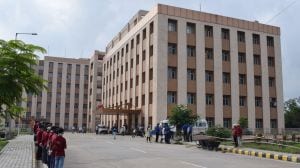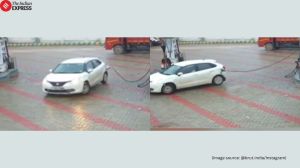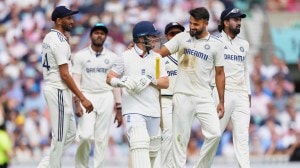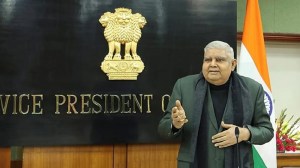Stay updated with the latest - Click here to follow us on Instagram
Atal Setu to be inaugurated today: India’s longest sea bridge becomes reality 6 decades after inception
The state government has fixed a toll charge of Rs 250 per car for a one way trip on the MTHL, with a concession option for frequent, regular commuter and pass holders.
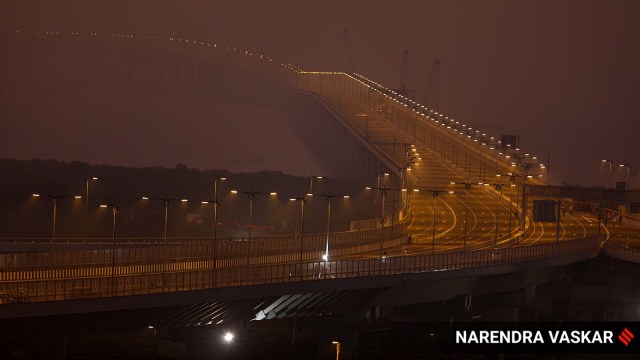 The 21.8 km Mumbai Trans Harbour Link will be inaugurated by Prime Minister Narendra Modi on January 12. (Express Photo by Narendra Vaskar)
The 21.8 km Mumbai Trans Harbour Link will be inaugurated by Prime Minister Narendra Modi on January 12. (Express Photo by Narendra Vaskar)The Atal Setu or Mumbai Trans Harbour Sealink (MTHL) was inaugurated on Friday by Prime Minister Narendra Modi, Maharashtra Chief Minister Eknath Shinde said. The Sealink will be the country’s longest sea bridge.
The 22 km-long six-lane bridge, connecting Sewri on the island city to Nhava-Sheva on the mainland, includes a 16.5 km long sea link and 5.5 km viaducts on land. 177,903 metric tonnes of steel and 504,253 metric tonnes of cement were used to build the MTHL. Currently, there are two access points to Navi Mumbai — one from Airoli-Mulund connector and second is the Vashi Connector. If one is going to Alibaug or Matheran or Lonavala, then they go via these connectors with heavy traffic.
Seen as a boon in the city known for its traffic snarls, MTHL will reduce travel time between Mumbai and Navi Mumbai and also lead to the economic integration of the neighbouring Raigad district into Mumbai’s ecosystem.
Connectivity between Mumbai and Navi Mumbai
- The connectivity of MTHL from Mumbai side will be at Sewri with an interchange that will connect MTHL to Eastern Freeway and the under construction Worli Sewri connector.
- The Connectivity of MTHL on Navi Mumbai side is at 3 locations:
Shivaji Nagar Interchange on Navi Mumbai side: The Sivaji Nagar interchange with CIDCO’s proposed Coastal Road will provided connectivity with Navi Mumbai International Airport & JNPT
Ramps at SH-54 near Jasai: Connectivity to Panvel – Uran State highway (SH-54)
Interchange at National Highway 4B near Jasai: This interchange will provide connectivity with Panvel, Uran and JNPT
Traffic projections, average travel time, cost, fuel savings
Once opened, the MTHL is projected to see 39,300 vehicles daily between the Sewri and Shivaji Nagar interchange, while 9,800 vehicles will run between the Shivaji Nagar and Chirle interchange
The bridge, designed to have a life of 100 years and carry 70,000 vehicles daily, will reduce the travel distance from South Mumbai to Chirle by around 30 km and as it will take around 16 minutes to cross the bridge, it will save at least an hour of commute time.
The toll has been fixed at Rs 250 per car single journey (one way). The return toll will be one-and-a-half times of the toll amount while daily pass will be two-and-a-half times of the toll. The monthly pass will be 50 times of the toll amount.
One crore litres of fuel are projected to be saved per year by the use of this bridge, apart from the reduction of pollution levels, by about 25680 metric tonnes less of CO2 emissions.
Atal Setu built keeping in mind monsoon winds, passenger safety
The MTHL will have specially-designed lighting poles to withstand high-velocity winds during monsoons, equipped with a Lightning Protection System to safeguard against potential damage caused by lightning.
Meanwhile, the safety of travellers will be ensured by crash barriers that are built, tested and meets international standards, with overall height of 1,550 mm. The barriers are a combination of concrete and metal with 900 mm of concrete section and the rest 650 mm is metal rail. It complies with International Standard EN 1317, a common testing and certification procedure for road restraint systems.
Noise barriers to protect sensitive stretches
From Sewri, an 8.5 km noise barrier and 6 km of view barrier has been installed, as the portion of the bridge passes through a flamingo protected area and BARC ( Bhabha Atomic Research Centre), which is a highly sensitive area. On the 7.807 km of stretch over the sea, over 900 metres of noise barrier and 1.2 km of view barrier have been installed.
Sea bridge was the most difficult part of project
The sea bridge, built at a height of 15 metres from sea level, was the most difficult and arduous part was the construction of the segments of the project. In the marine portion, engineers and workers had to dig as deep as 47 metres in the sea bed. The bridge lying close to sensitive establishments like ONGC, JNPT and BARC made the construction of these segments more difficult, with engineers having to take care that they do not damage any underwater installations like pipelines or communication cables.
Over 5,000 workers employed by project, seven died
MMRDA documents state that on an average, a total of 5,403 workers and engineers worked every day for completion of the project since work began in mid-2018. Seven labourers lost their lives while constructing the project. Most of the labourers hired were from states like Bihar, Odisha, Uttar Pradesh, Punjab and Maharashtra. Almost all these fatal accidents took place when these workers were working on the first package of the project which entailed constructing a 10.380 km-long bridge section across Mumbai Bay including Sewri Interchange.
Covid-induced delays caused cost escalation
MTHL saw a cost escalation of Rs 2,192 crore or 14.9 per cent, according to information obtained through a Right to Information (RTI) query by activist Anil Galgali. The original cost of Rs 14,712.70 crore increased to Rs 16,904.43 crore owing to delays due to Covid-induced lockdowns.
Project was first proposed six decades ago
The idea of a connector linking the Island City of Mumbai to the mainland was first proposed in 1962 in a study titled ‘Planning of Road System for Mumbai Metropolitan Region’. It took the Maharashtra government close to 34 years to initiate a feasibility report of the project in 1994. The project was stuck behind red tape for another decade before the study was updated in 2004 and tenders called in 2006. In 2017, the project was revived with the MMRDA signing an agreement with Japan International Cooperation Agency, which is providing development loan assistance of Rs 15,100 crore for the project. Work on the project began in April 2018.
Real estate experts say market will see significant growth
Gautam Thacker, Chairman NAREDCO Neral-Karjat unit, said, “The Mumbai address has changed as a lot of construction has begun in MMR. Many homebuyers are showing interest in properties in MMR. With the upcoming MTHL and Navi Mumbai Airport projects, untouched areas will see significant growth. It is a given, that connectivity has a positive impact on real estate development. Micro markets like Ulwe, Panvel, Kharghar among others are seeing growth in real estate pricing, and it will go up further.”
Economic growth
MTHL will accelerate growth in Mumbai and MMR in terms of economy, as India envisages to become a 5 trillion growth economy. The MTHL will give impetus to economic growth by opening up new avenues and businesses opportunities, an MMRDA official said.








